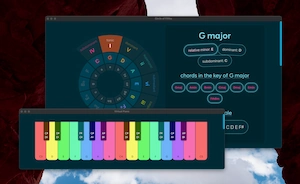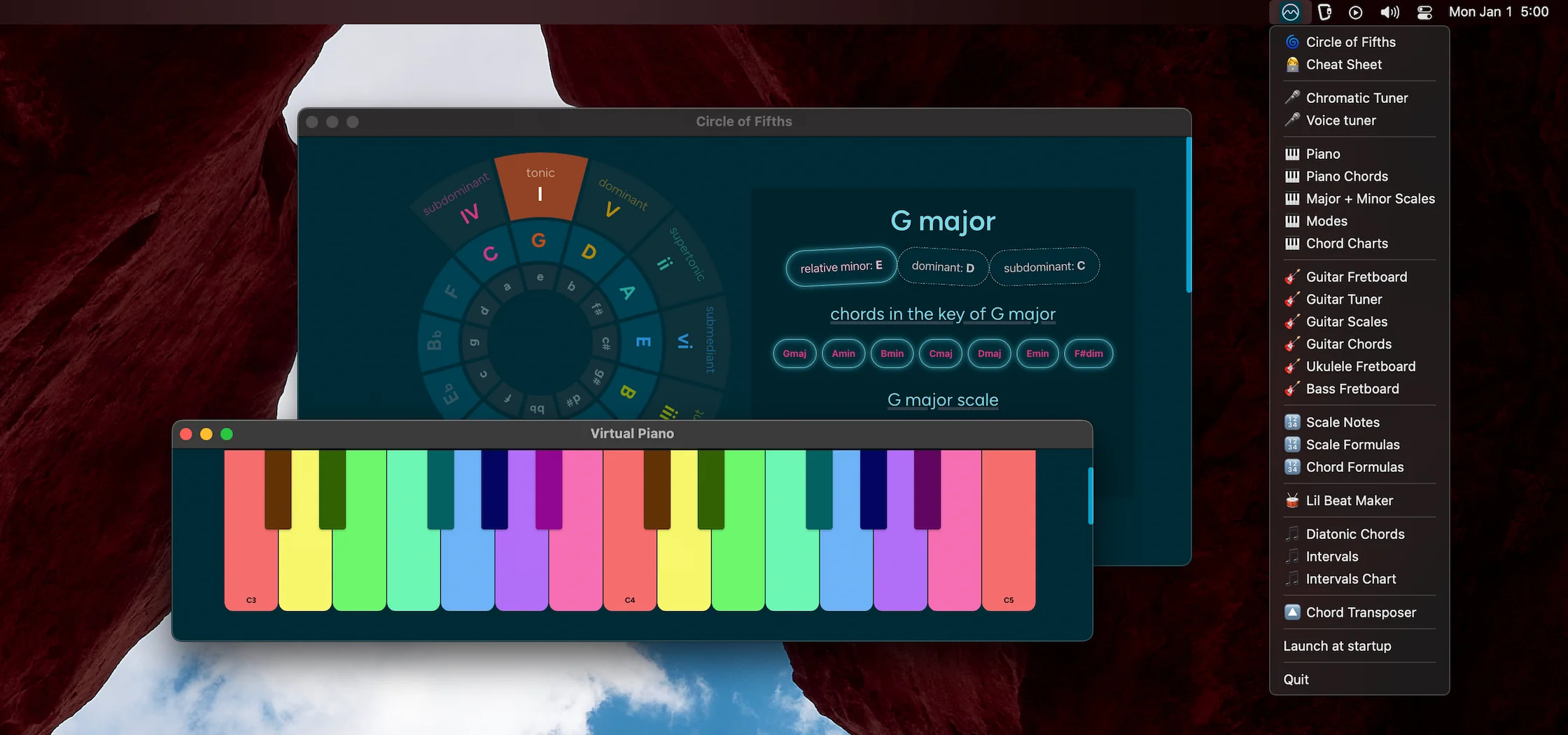Interactive Circle of Fifths Chart
✨ An interactive circle of fifths chart, a very useful music
theory tool to help visualize scales, notes, chords and keys as well as the
relationship between them.
🌀 As the name implies, in the Circle of Fifths (aka wheel of fifths), each
note/key on the wheel is separated by a
perfect fifth. You can click the toggle to switch
between the major circle of fifths (Ionian mode) and the minor circle of fifths (Aeolian mode).
🔄 When going counter-clockwise on the circle, we get a
circle of fourths. For example, the
interval between the
key of C and the
key of F is a perfect fourth.
Click on any of the 12 keys to select the tonic.
C major
relative minor: A
dominant: G
subdominant: F
chords in the key of C major
C major scale
notes: C D E F G A B
→ full C major scale/chord referenceG major
relative minor: E
dominant: D
subdominant: C
chords in the key of G major
G major scale
notes: G A B C D E F♯
→ full G major scale/chord referenceD major
relative minor: B
dominant: A
subdominant: G
chords in the key of D major
D major scale
notes: D E F♯ G A B C♯
→ full D major scale/chord referenceA major
relative minor: F♯
dominant: E
subdominant: D
chords in the key of A major
A major scale
notes: A B C♯ D E F♯ G♯
→ full A major scale/chord referenceE major
relative minor: C♯
dominant: B
subdominant: A
chords in the key of E major
E major scale
notes: E F♯ G♯ A B C♯ D♯
→ full E major scale/chord referenceB major
relative minor: G♯
dominant: G♭/F♯
subdominant: E
chords in the key of B major
B major scale
notes: B C♯ D♯ E F♯ G♯ A♯
→ full B major scale/chord referenceG♭/F♯ major
relative minor: D♯
dominant: D♭
subdominant: B
chords in the key of G♭/F♯ major
G♭/F♯ major scale
notes: G♭ A♭ B♭ C♭ D♭ E♭ F
→ full G♭/F♯ major scale/chord referenceD♭ major
relative minor: A♯/B♭
dominant: A♭
subdominant: G♭/F♯
chords in the key of D♭ major
D♭ major scale
notes: D♭ E♭ F G♭ A♭ B♭ C
→ full D♭ major scale/chord referenceA♭ major
relative minor: F
dominant: E♭
subdominant: D♭
chords in the key of A♭ major
A♭ major scale
notes: A♭ B♭ C D♭ E♭ F G
→ full A♭ major scale/chord referenceE♭ major
relative minor: C
dominant: B♭
subdominant: A♭
chords in the key of E♭ major
E♭ major scale
notes: E♭ F G A♭ B♭ C D
→ full E♭ major scale/chord referenceB♭ major
relative minor: G
dominant: F
subdominant: E♭
chords in the key of B♭ major
B♭ major scale
notes: B♭ C D E♭ F G A
→ full B♭ major scale/chord referenceF major
relative minor: D
dominant:
subdominant: B♭
chords in the key of F major
F major scale
notes: F G A B♭ C D E
→ full F major scale/chord referenceA minor
relative major: C
dominant: E
subdominant: D
chords in the key of A minor
A minor scale
notes: A B C D E F G
→ full A minor scale/chord referenceE minor
relative major: G
dominant: B
subdominant: A
chords in the key of E minor
E minor scale
notes: E F♯ G A B C D
→ full E minor scale/chord referenceB minor
relative major: D
dominant: F♯
subdominant: E
chords in the key of B minor
B minor scale
notes: B C♯ D E F♯ G A
→ full B minor scale/chord referenceF♯ minor
relative major: A
dominant: C♯
subdominant: B
chords in the key of F♯ minor
F♯ minor scale
notes: F♯ G♯ A B C♯ D E
→ full F♯ minor scale/chord referenceC♯ minor
relative major: E
dominant: G♯
subdominant: F♯
chords in the key of C♯ minor
C♯ minor scale
notes: C♯ D♯ E F♯ G♯ A B
→ full C♯ minor scale/chord referenceG♯ minor
relative major: B
dominant: D♯
subdominant: C♯
chords in the key of G♯ minor
G♯ minor scale
notes: G♯ A♯ B C♯ D♯ E F♯
→ full G♯ minor scale/chord referenceD♯ minor
relative major: G♭/F♯
dominant: A♯/B♭
subdominant: G♯
chords in the key of D♯ minor
D♯ minor scale
notes: D♯ E♯ F♯ G♯ A♯ B C♯
→ full D♯ minor scale/chord referenceA♯/B♭ minor
relative major: D♭
dominant: F
subdominant: D♯
chords in the key of A♯/B♭ minor
A♯/B♭ minor scale
notes: A♯ B♯ C♯ D♯ E♯ F♯ G♯
→ full A♯/B♭ minor scale/chord referenceF minor
relative major: A♭
dominant: C
subdominant: A♯/B♭
chords in the key of F minor
F minor scale
notes: F G A♭ B♭ C D♭ E♭
→ full F minor scale/chord referenceC minor
relative major: E♭
dominant: G
subdominant: F
chords in the key of C minor
C minor scale
notes: C D E♭ F G A♭ B♭
→ full C minor scale/chord referenceG minor
relative major: B♭
dominant: D
subdominant: C
chords in the key of G minor
G minor scale
notes: G A B♭ C D E♭ F
→ full G minor scale/chord referenceD minor
relative major: F
dominant:
subdominant: G
chords in the key of D minor
D minor scale
notes: D E F G A B♭ C
→ full D minor scale/chord reference💡 The outermost section on the circle represents the scale degrees along with their roman numerals, the large circle represent the 12 keys in the selected mode (Major/Ionian or Minor/Aeolian) and the inner circle represents the relative keys.
The above circle of fifths highlights the scale degrees to make it easy to see the notes that form each major or minor scale. Next let's go over other useful information about notes, scales, chords, keys and key signatures that we get from the Circle of Fifths:
Key Signatures
(number of sharps or flats)
Going clockwise from the key of C, we add a sharp for each successive key. Going counter-clockwise from C, we add a flat for each successive key. See here for a reference on key signatures.

Diatonic Chords
We can visualize what the different diatonic chords are for a given key as the diatonic chords will always be at the same relative position to the key.
Here for example we see the key of A major and its diatonic chords:
- I: A
- ii: Bm
- iii: C♯m
- IV: D
- V: E
- vi: F♯m
- vii°: G♯°
Or the key of F♯ minor and its diatonic chords:
- i: F♯m
- ii°: G♯°
- III: A
- iv: Bm
- v: C♯m
- VI: D
- VII: E
See also: diatonic chord player.


Intervals
We already know that, going clockwise by one key we get the key that's a perfect fifth away. We also know that, going counter-clockwise by one key we get the key that's a perfect fourth away. Here are some more intervals that are easy to find on the circle of fifths:
The tritone, which is an interval of 6 semitones, is always at the exact opposite of a key on the circle of fifths.

The major third, which is an interval of 4 semitones, is always 4-keys away clockwise on the circle of fifths.

The minor third, which is an interval of 3 semitones, is always 3-keys away counter-clockwise on the circle of fifths.

Order of Sharps & Order of Flats
The order of sharps is F C G D A E B. So
if we know that a key has 3 sharps, we'll know that those
sharps are
F♯, C♯ and G♯ .
The order of flats is the same, but in the opposite direction:
B E A D G C F. If a key has two flats, we
know that those flats are
B♭ and E♭.
See here for a reference.

Learning more about the circle of fifths
The circle of fifths helps to see keys that harmonize well with a selected key, which can help with music composition. Keys that are adjacent to another key in the circle of 5ths are closely related and will usually harmonize well. In fact, keys that are a fifth apart only differ by one note, having 6 notes in common.
The circle of fifths also helps to determine the key signature of a given key. Starting from the key of C (or the key of A on the minor circle of 5ths) and going clockwise, each successive key gets an additional sharp at the 7th scale degree. For example, the key of C has no sharps, while the key of G (the key one fifth apart from C in a clockwise direction) has one sharp at the 7th scale degree. Similarly, going counter-clockwise, each successive key gets an additional flat at the 4th scale degree.
For a circle of fifths that also includes the 7 modes of the major scale, I recommend this circle of 5ths by Rand Scullard.
If you're interested in learning more about the circle of fifths in general, here's a very detailed post from Musical U, and here's an awesome video by Brian from Zombie Guitar that makes the circle of fifths and its applications quite simple to grasp.



